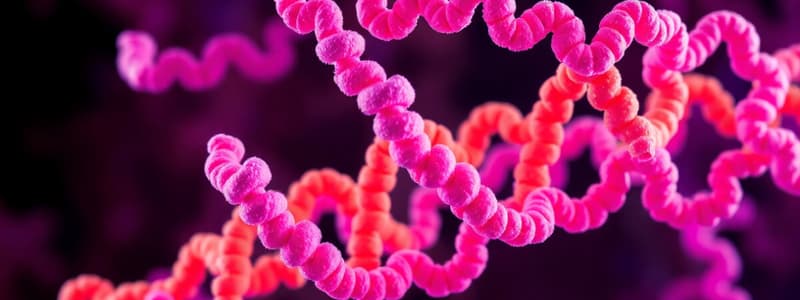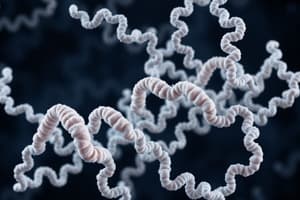Podcast
Questions and Answers
What determines the specific three-dimensional shape of proteins?
What determines the specific three-dimensional shape of proteins?
- The type of substrate the protein interacts with
- The side chain properties of amino acids (correct)
- Hydrogen bonds and ionic interactions
- The sequence of nucleotides in DNA
What role do chaperones play in protein synthesis?
What role do chaperones play in protein synthesis?
- They assist in the correct folding of proteins (correct)
- They promote the aggregation of proteins
- They provide energy for protein synthesis
- They are involved in the transcription of DNA
Which of the following statements about enzymes is true?
Which of the following statements about enzymes is true?
- Enzymes lower the activation energy for reactions (correct)
- Enzymes function without any specific active sites
- Enzymes can be permanently altered by their substrates
- All enzymes work in all types of biological reactions
What is the induced fit model in enzyme activity?
What is the induced fit model in enzyme activity?
What is feedback inhibition in metabolic pathways?
What is feedback inhibition in metabolic pathways?
What is the primary function of the mitochondria in cells?
What is the primary function of the mitochondria in cells?
Which organelle is responsible for lipid synthesis?
Which organelle is responsible for lipid synthesis?
What is the primary role of the plasma membrane in a cell?
What is the primary role of the plasma membrane in a cell?
What is the primary function of the Golgi apparatus?
What is the primary function of the Golgi apparatus?
Which statement correctly describes ribosomes?
Which statement correctly describes ribosomes?
What distinguishes eukaryotic cells from prokaryotic cells?
What distinguishes eukaryotic cells from prokaryotic cells?
What is the structure of DNA characterized by?
What is the structure of DNA characterized by?
Which type of chromatin is associated with active transcription?
Which type of chromatin is associated with active transcription?
What is the role of the nucleolus within a cell?
What is the role of the nucleolus within a cell?
What type of microscopy is best for viewing detailed organelle structures?
What type of microscopy is best for viewing detailed organelle structures?
Which of the following statements about chemical bonds is NOT true?
Which of the following statements about chemical bonds is NOT true?
Flashcards are hidden until you start studying
Study Notes
Protein Structure and Function
- Proteins are polymers of amino acids that fold into specific three-dimensional shapes crucial for their biological roles.
- There are 20 different amino acids, all in L-form; properties of side chains affect protein behavior (hydrophobic or hydrophilic).
- Protein folding is primarily driven by non-covalent interactions including hydrogen bonds, ionic bonds, and hydrophobic interactions.
- Chaperones are proteins that assist in the correct folding of other proteins, preventing misfolding and aggregation.
- Secondary structures of proteins include alpha-helices and beta-sheets, which are stabilized by hydrogen bonding.
- Enzymes function as biological catalysts, reducing activation energy and allowing for biochemical reactions to occur efficiently.
- The active site of an enzyme is the region where substrates bind, with the induced fit model explaining how enzymes adjust to accommodate substrates.
- Feedback inhibition is a regulatory mechanism that prevents overproduction of metabolic products by inhibiting early pathway steps.
- Non-covalent bonds, essential for protein stability, encompass hydrogen bonds, ionic interactions, van der Waals forces, and hydrophobic effects.
- Phosphorylation plays a key role in regulating protein function by adding or removing phosphate groups, impacting cellular signaling.
Cell Organelles
- Organelles are specialized cellular structures that perform distinct functions critical for cell operation.
- Plasma membrane serves as a protective barrier, regulating the movement of substances into and out of the cell.
- The nucleus houses genetic material (DNA) and is the site of transcription and ribosome assembly.
- Mitochondria are known as the cell's powerhouse, generating ATP through cellular respiration and found in both plant and animal cells.
- Chloroplasts enable photosynthesis in plant cells, transforming light energy into chemical energy.
- Endoplasmic Reticulum (ER) includes Rough ER (protein synthesis) and Smooth ER (lipid synthesis).
- Golgi apparatus modifies, sorts, and packages proteins for cellular transport and secretion.
- Ribosomes are the sites of protein synthesis, existing freely or attached to the rough ER.
- All cells share fundamental structures (membrane, cytoplasm, DNA, and ribosomes) yet exhibit specialized functions based on organelle composition.
- Microscopy techniques vary in resolution: Light Microscopy (lower resolution, live cells) and Electron Microscopy (high resolution for detailed organelle imagery).
- Key concepts include: eukaryotic cells having membrane-bound organelles, the endosymbiosis theory on mitochondrial and chloroplast origins, and the importance of non-covalent interactions in organelle structure and function.
DNA Structure
- DNA is organized as a double helix with two antiparallel strands, featuring a sugar-phosphate backbone and specific nitrogenous base pairing (A-T, G-C).
- The distance between base pairs is approximately 1 nm, crucial for the structural integrity of DNA.
- Nucleosomes are the basic units of chromatin, formed by DNA wrapped around histone proteins.
- Chromatin is classified into euchromatin (loosely packed, transcriptionally active) and heterochromatin (condensed, transcriptionally inactive).
- The DNA packaging hierarchy progresses from nucleosomes to chromatin fibers to chromosomes.
- Most genes encode proteins; some genes produce functional RNAs like tRNA and rRNA.
- Karyotypes display organized chromosome presentations that are significant for clinical analysis.
- The nucleolus is a site for ribosomal RNA synthesis and assembly, as well as gene regulation through chromatin remodeling, which requires ATP.
Studying That Suits You
Use AI to generate personalized quizzes and flashcards to suit your learning preferences.




